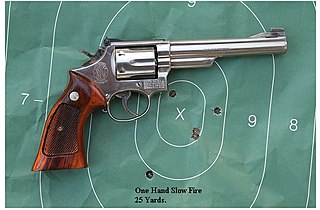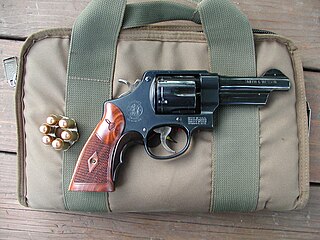
A revolver is a repeating handgun with at least one barrel and uses a revolving cylinder containing multiple chambers for firing. Because most revolver models hold up to six cartridges, before needing to be reloaded, revolvers are commonly called six shooters or sixguns. Due to their rotating cylinder mechanism, they may also be called wheel guns.

The .40 S&W (10.2×22mm) is a rimless pistol cartridge developed jointly by American firearms manufacturers Smith & Wesson and Winchester in 1990. The .40 S&W was developed as a law enforcement cartridge designed to duplicate performance of the Federal Bureau of Investigation's (FBI) reduced-velocity 10mm Auto cartridge which could be retrofitted into medium-frame semi-automatic handguns. It uses 0.40-inch-diameter (10 mm) bullets ranging in weight from 105 to 200 grains.

The Smith & Wesson Model 29 is a six-shot, double-action revolver chambered for the .44 Magnum cartridge and manufactured by the United States company Smith & Wesson.

The 10mm Auto is a powerful and versatile semi-automatic pistol cartridge introduced in 1983. Its design was adopted and later produced by ammunition manufacturer FFV Norma AB of Åmotfors, Sweden.

The .32 S&W Long / 7.65x23mmR, often called the .32 Long, is a straight-walled, centerfire, rimmed handgun cartridge, based on the earlier .32 S&W cartridge. It was introduced in 1896 for Smith & Wesson's first-model Hand Ejector revolver. Colt called it the .32 Colt New Police in revolvers it made chambered for the cartridge.

The Smith & Wesson Model 19 is a revolver produced by Smith & Wesson that was introduced in 1957 on its K-frame. The Model 19 is chambered for .357 Magnum. The K-frame is somewhat smaller and lighter than the original N-frame .357, usually known as the Smith & Wesson Model 27. A stainless steel variant of the Model 19, the Smith & Wesson Model 66, was introduced in 1971.

A moon clip is a ring-shaped or star-shaped piece of metal designed to hold multiple cartridges together as a unit, for simultaneous insertion and extraction from a revolver cylinder. Moon clips may either hold an entire cylinder's worth of cartridges together, half a cylinder, or just two neighboring cartridges. The two-cartridge moon clips can be used for those revolvers that have an odd number of loading chambers such as five or seven and also for those revolvers that allow a shooter to mix both rimless and rimmed types of cartridges in one loading of the same cylinder.

The Smith & Wesson Model 586, is a six- or seven-shot double-action revolver chambered for the .357 Magnum cartridge; it will also chamber and fire .38 Special cartridges. The Model 586 has a carbon steel construction and is available in a blued or nickel finish; it is essentially the same firearm as the Model 686, which has stainless steel construction. It is also known as the Distinguished Combat Magnum.

The Smith & Wesson Model 686 is a six- or seven-shot double-action revolver manufactured by Smith & Wesson and chambered for the .357 Magnum cartridge; it will also chamber and fire .38 Special cartridges. Smith & Wesson introduced the Model 686 in 1981. It is the stainless steel version of the Model 586, which featured a blued steel finish. They are available ported and unported with a choice of 6- or 7-round cylinders.

The Smith & Wesson Model 625, is a six-round, double-action revolver chambered for the .45 ACP using moon clips. The Model 625 is an improved stainless steel version Smith & Wesson Model 22 and a direct descendant of the Smith & Wesson M1917 revolver first issued during World War I.

The M1917 Revolvers were six-shot, .45 ACP, large frame double action revolvers adopted by the United States Military in 1917, to supplement the standard M1911 pistol during World War I. There were two variations of the M1917, one made by Colt and the other by Smith & Wesson. They used moon-clips to hold the cartridges in position, facilitate reloading, and to aid in extraction since revolvers had been designed to eject rimmed cartridges and .45 ACP rounds were rimless for use with the magazine-fed M1911. After World War I, they gained a strong following among civilian shooters. A commercial rimmed cartridge, the .45 Auto Rim, was also developed, so M1917 revolvers could eject cartridge cases without using moon-clips.

The Smith & Wesson K-22 Target Masterpiece Revolver is a six-shot, double-action revolver with adjustable open sights, built on the medium-size "K" frame. When introduced, it was intended for bullseye target shooting competition of the type then most common on the United States, which is today called NRA Precision Pistol, specifically in the "smallbore" or "22" category. It is chambered for the .22 Long Rifle cartridge. It is one of three similar models that Smith & Wesson offered, the other two being intended for the "centerfire" category, the K-32 Target Masterpiece chambered for the .32 S&W Long cartridge and the K-38 Target Masterpiece chambered for the .38 Special cartridge. Most K-22 revolvers were fitted with a 6 in (150 mm) or 8+3⁄8 in (210 mm) barrel, but other lengths have been produced. First produced in 1947 and originally known as the K-22 Target Masterpiece, it was numbered the Model 17 in 1957 when all Smith & Wesson guns were given numerical model numbers. It is built on the same frame as the seminal Smith & Wesson Model 10 revolver.

The Colt Delta Elite is a modified series 80 M1911 pistol chambered for the 10mm Auto cartridge. It was first introduced in 1987 by the Colt's Manufacturing Company.

The GP100 is a family/line of double action five-, six-, seven-, or ten-shot revolvers made by Sturm, Ruger & Co., manufactured in the United States. Since its introduction, it has been produced with a number of variations including various barrel lengths and profiles, fixed or adjustable sights, and in blued carbon steel or stainless steel.

A snubnosed revolver is a small, medium, or large frame revolver with a short barrel, generally less than 3 inches in length. Smaller such revolvers are often made with "bobbed" or "shrouded" hammers and there are also "hammerless" models ; the point is to allow the gun to be drawn with little risk of it snagging on clothing. Since the external movement of the mechanism is minimal or nil, shrouded and hammerless models may be fired from within clothing. The design of these revolvers compromises range and accuracy at a distance in favor of maneuverability and ease of carry and concealment.

S&W Centennial is a family of revolvers made by Smith & Wesson on the "J-Frame". Depending upon caliber, the cylinder holds either 5, 6, 7, or 8 cartridges. Centennials feature a fully enclosed (internal) hammer, which makes them Double Action Only (DAO) firearms. Like all other "J-frame" Smith & Wesson revolvers, they have a swing-out cylinder. Centennial models have been made in different versions like PD "Personal Defense", LS "Lady Smith", and M&P "Military & Police"

A handgun is a firearm designed to be usable with only one hand. It is distinguished from a long barreled gun which needs to be held by both hands and braced against the shoulder. Handguns have shorter effective ranges compared to long guns, and are much harder to shoot accurately. While most early handguns are single-shot pistols, the two most common types of handguns used in modern times are revolvers and semi-automatic pistols, although other handguns such as derringers and machine pistols also see infrequent usage.

The Smith & Wesson Model 22 is a 6-shot, double-action, large frame revolver chambered in .45 ACP using moon clips. It's a refined commercial version of the M1917 revolver first issued during World War I.
The Smith & Wesson Model 646 is a six-shot, double-action revolver chambered for the .40 S&W pistol cartridge, manufactured in 2000 and 2003 by the United States company Smith & Wesson.

The Smith & Wesson Governor is a snub-nosed single-action/double-action revolver built on the Z-frame and utilizes a K-frame grip with a lightweight scandium alloy or stainless steel frame.




















